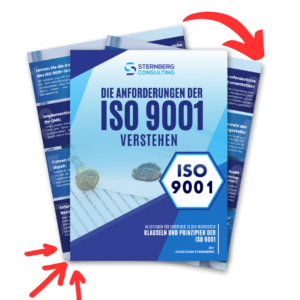ISO 9001 Section 10 – Improvement clearly explained
ISO 9001:2015 SECTION 10 “IMPROVEMENT”
“If you rest, you rust” – a well-known saying that applies not only to the human mind and body, but also to quality management systems. Such a system must never stand still, but must continually develop. ISO 9001:2015 emphasizes the need for continuous improvement in Section 10. Corrective measures and the elimination of non-conformities are seen as essential elements for maintaining and increasing company performance. Efficient improvement processes are crucial so that companies can continually improve their operations and the provision of products and services and thus sustainably increase customer satisfaction.
10.1 General
Clause 10.1 (General) of ISO 9001:2015 emphasizes that the organization shall identify opportunities for improvement and shall take the necessary actions to meet customer requirements and increase customer satisfaction. Improvements may include improving products and services to meet requirements and future needs, correcting or reducing undesirable effects and thereby improving the performance and effectiveness of the quality management system.
What does that mean in concrete terms?
In particular, Clause 10.1 requires organizations to: Actively strive for improvement: Organizations must proactively identify and implement opportunities to better meet customer needs and increase satisfaction. This includes a regular, critical review of QMS processes, products, services and overall performance. Predictive product improvement: It is not enough to just meet current requirements. Companies should also anticipate future needs and expectations and develop their offerings accordingly. This future-oriented approach helps to stay relevant in the long term. Minimization of undesirable effects: Negative effects in relation to products, processes or the QMS itself must be consistently corrected, prevented or at least reduced. In this way, quality problems and their consequences can be effectively contained. Continuous development of the QMS: The quality management system must not be static, but must be constantly improved in terms of suitability, appropriateness and effectiveness. This is the only way to remain in line with the changing conditions and the strategic direction of the company.
How can this be implemented in practice?
- Review performance and feedback
Regularly review process performance data, customer feedback, audit results, and changes in internal/external issues to identify opportunities for improvement.
- Use quality improvement tools
Use quality tools such as root cause analysis, FMEA, Pareto charts, etc. to analyze problems and develop targeted improvements.
- Promote employee participation
Encourage employees to participate in identifying improvement ideas. Implement a suggestion system and reward contributions.
- Implement a corrective action process
Implement a clearly defined corrective action process to identify root causes, develop solutions and verify their effectiveness.
- Provide improvement training
Training employees in concepts, methods and tools for continuous improvement. Build their skills to participate in improvement projects. By implementing these practices, organizations can systematically identify, prioritize and track improvement opportunities to improve customer satisfaction and business performance in accordance with the requirements of ISO 9001 Section 10.1.
10.2 Non-Conformity and Corrective Actions
Section 10.2 of ISO 9001:2015 describes the process for resolving nonconformities and implementing corrective actions within an organization’s quality management system. It emphasizes the importance of promptly resolving nonconformities to maintain product/service quality and customer satisfaction.
What does that mean in concrete terms?
When a nonconformity occurs, companies must respond promptly by reviewing and analyzing the problem, identifying its causes, and assessing potential similar occurrences. This process includes implementing the necessary actions to resolve the nonconformity and verifying the effectiveness of the corrective actions taken. Additionally, companies must distinguish between corrective action (immediate action) and corrective action (addressing root causes) and use problem-solving tools such as root cause analysis to identify underlying problems.
How can this be implemented in practice?
When nonconformity occurs within an organization, immediate action must be taken to effectively address and resolve the issue.
Dealing with non-conformities:
When nonconformity occurs within an organization, immediate action must be taken to effectively address and resolve the issue. According to the ISO 9001:2015 standard, organizations are required to respond to non-conformities. Dealing with nonconformities involves several steps: First, the deviation must be thoroughly checked and analyzed. The causes must then be identified and possible similar incidents assessed. Based on this, the necessary measures are implemented and their effectiveness is checked. Finally, the risks and opportunities identified during planning should be updated and relevant changes made to the quality management system.
Assessment of non-conformities:
Not every mistake has the same severity. Evaluate the significance of non-conformities considering their impact on products, services and customer satisfaction. Based on this assessment, determine the need for corrective action.
Distinction between correction and corrective action:
Distinguish between corrective action (immediate action to resolve a detected nonconformity) and corrective action (addressing the root cause to prevent recurrence).
Root cause analysis:
Problem-solving tools, such as Other tools, such as 5-Why, Ishikawa, 8D Report, and statistical methods, are helpful tools in identifying the causes of problems and implementing effective corrective actions. Implement corrective actions that target these causes to prevent similar problems from occurring again.
Corrective Actions – More than just fixing errors
Once the causes of a problem have been identified, corrective measures are a given for many companies, even without a certified quality management system. But a crucial step is often neglected: monitoring the effectiveness of implemented measures. At first glance, the effectiveness may seem clear, but appearances can be deceiving. The suspected causes of a problem are not always present. Unrecognized factors can lie dormant and undermine the effectiveness of corrective actions. This is exactly where monitoring comes into play. It ensures that the measures taken actually work and get to the root of the problem. This is the only way to say with certainty that the right steps have been taken and the non-conformity has been permanently remedied.
Documentation and integration into the management review
To ensure compliance with standard requirements, organizations must maintain documented information about nonconformities encountered, actions taken, and the results of corrective actions. These should also be the subject of regular management reviews in order to assess and control the effectiveness of error management at the highest level.
Prevention – The key to avoiding errors
However, prevention is even better than correction. This is where preventive measures come into play to prevent errors from occurring in the first place. Based on a careful risk assessment of individual process steps or entire processes, potential weak points can be identified and proactively addressed. Through targeted preventative measures, companies can rule out undesirable situations and non-conformities from the outset. This not only saves you resources for complex corrections, but also increases the quality of your products and services.
10.3 Continuous Improvement
Section 10.3 of ISO 9001:2015 emphasizes the importance of continuous improvement practices within an organization’s quality management system to effectively meet customer expectations and ensure compliance with ISO requirements. It highlights aspects such as: E.g. identifying improvement goals, establishing a continuous improvement process, collecting customer feedback, thorough documentation, regular review and evaluation, compliance with ISO requirements and using management reviews for improvement measures.
What does that mean in concrete terms?
Companies are encouraged to regularly assess and identify areas for improvement to increase efficiency and effectiveness. You should establish a systematic process for continuous improvement of quality management systems and processes. Effective communication and structured feedback mechanisms with stakeholders such as customers and employees are essential to identify areas for improvement and validate the impact of implemented changes. Thorough documentation of improvement initiatives, including changes made and their impact, is necessary. Regular assessments should be conducted to assess the effectiveness of the implemented changes and identify further opportunities for improvement. Compliance with ISO 9001:2015 continuous improvement requirements is critical and management reviews should be used to determine required improvement actions.
How can this be implemented in practice?
Identification of improvement targets: Regularly assess and identify areas within the organization that can be improved to increase efficiency and effectiveness.
- Continuous improvement process: Establish a systematic process that enables continuous improvement of quality management systems and processes.
- Communication and customer feedback: Establish structured feedback mechanisms to collect input from relevant stakeholders such as customers and employees. Use this feedback to identify areas for improvement and validate the effectiveness of the implemented changes.
- Documentation: Thoroughly document the results of improvement initiatives, including changes made, lessons learned, and their impact on overall performance. Disseminate the results of improvement efforts to relevant stakeholders.
- Review and Evaluation: Conduct periodic reviews to review the results of improvement efforts. Measure the effectiveness of implemented changes and identify avenues for further improvement.
- ISO Requirements: Adhere to the requirements of the ISO 9001:2015 standard for continuous improvement of the suitability, adequacy and effectiveness of the quality management system.
- Management Review: Use the results of analyses, assessments and outputs from management reviews to determine the necessary measures for continuous improvement.
Conclusion
ISO 9001:2015 Section 10 emphasizes the importance of continuous improvement of quality management systems. By focusing on identifying opportunities for improvement, aligning actions with customer needs, and implementing preventive and corrective actions, companies can strive for excellence and increase customer satisfaction. According to a study by the American Society for Quality, companies that embrace continuous improvement see a 10% increase in customer satisfaction and a 7% increase in profitability.
Share this article
Written by : Jonathan
Inhalt:

Buchen Sie einen Beratungstermin
Buchen Sie einen Termin und besprechen Sie mit uns wie wir Sie bei der Zertifizierung oder andern QM-Themen unterstützen können
ISO 9001 – Leicht gemacht.
Erfahren Sie in unserem E-Book die Anforderungen der ISO 9001, die der Norm zugrundeliegenden Grundprinzipien, und den Zertifizierungsprozess
Latest articles
July 24, 2024
July 24, 2024





